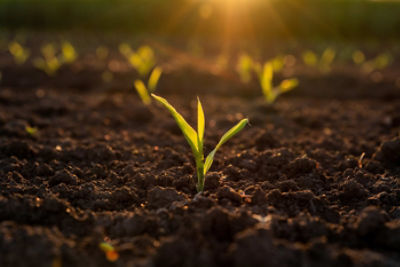A primary goal of corn growers is to achieve stands containing uniformly large-sized plants that consistently produce 1 full-sized ear each. Small, delayed or "runt" plants rarely, if ever, produce full-sized ears. Traditionally, growers have assumed that the primary cause of these smaller, undesirable plants was a delay in the time of emergence. And often the cause for delayed emergence was assumed to be inconsistent seeding depth. Logically, late-emerging plants are less able to compete for limited light, nutrient, and moisture resources with earlier-emerging and larger neighbors. Several studies have indeed documented significant yield loss when the development of plants within the stand was delayed (Nafziger et al., 1991; Ford and Hicks, 1992; Liu et al., 2004a, 2004c). These studies typically used multiple planting dates 7 to 28 days apart to achieve varying degrees of delayed plant growth. These studies are valuable in demonstrating certain aspects of plant-to-plant competition and give some guidance for making replant decisions. But they are of little value in understanding the effects of time of emergence on individual plant yield in stands planted all on the same day, as is typical in commercial corn production. They also do not indicate the relative importance of time of emergence versus other factors occurring after stand establishment or how final plant yield is impacted by each.
Multiple factors shown to affect plant yield
There is widespread agreement that large plants exhibiting well-synchronized silk emergence and pollen shed produce the largest and most consistent-sized ears (Pagano et al., 2007; Kovács and Vyn, 2014). However, these studies have also shown that time of emergence has relatively little effect on plant biomass and final grain yield. In a 2-year study in Indiana, Murua (2002) documented that time of emergence in conventionally-planted corn stands only explained about 4% of the variation in individual plant yield. A similar study by Kovács and Vyn (2014) found that value to be only about 1%.
Other studies from Argentina found that even when corn canopies emerge uniformly, they can develop well-established plant hierarchies as early as the V4 growth stage (Pagano et al., 2007; Maddonni and Otegui, 2004). These differences in plant size within the stand are probably explained by "other" factors such as moisture availability, compaction, soil textural differences, nutrient acquisition or insect damage, and clearly not time of emergence. The notion that a plant emerging more than 48 hours after its neighbors is a "weed" is clearly not supported by these studies. In fact, Kovács and Vyn (2014) further warn, "the importance of ultra-uniform seedling emergence times for adjacent plants within the row can easily be overstated."
How much does uniform emergence affect plant yield?
Determining the exact effect of uniform emergence is difficult, in part because studies have used different ways to measure and express emergence uniformity. Some of the different measures used include calendar or growing degree days from planting to emergence, time to 50% emergence, number of leaf stage growth differences and days of emergence delay after the mean emergence date of the plant stand. Ford and Hicks (1992) measured a 6% yield loss when every second plant had a 1-leaf stage delay and a 5% yield loss when every sixth plant had a 2-leaf delay. Liu et al. (2004a, 2004c) found that yield decreased 2% per day whenever the time to 50% emergence was delayed by more than 3 days. Nishikawa and Kudo (1973) report that per plant yield declines by 5% for every day in emergence delay after the mean emergence date of the plant stand. And finally, Murua (2002) measured an average of 2.3% yield loss for every additional day's delay in emergence of individual plants.
These results suggest that delays in emergence can result in average yield losses in the 5% to 9% range proposed by Coulter. Careful attention to managing planting depth, seed trench compaction, surface crusting, seed furrow closure and surface residue will minimize these yield losses. But beyond that, attention to other factors, such as uniform moisture and nutrient availability, soil compaction and disease and insect protection may be even more important in achieving uniform stands at physiological maturity with low plant-to-plant variability in ear size and maximum grain yield.
